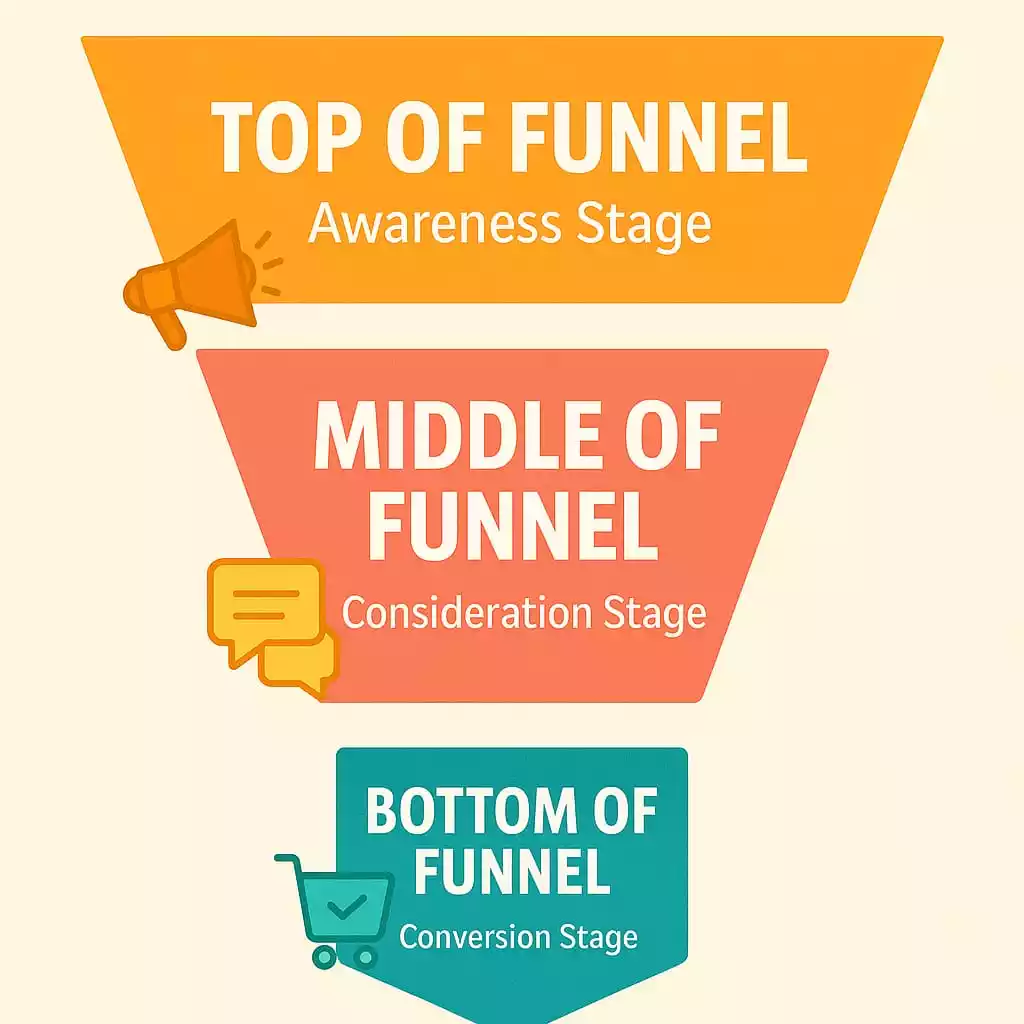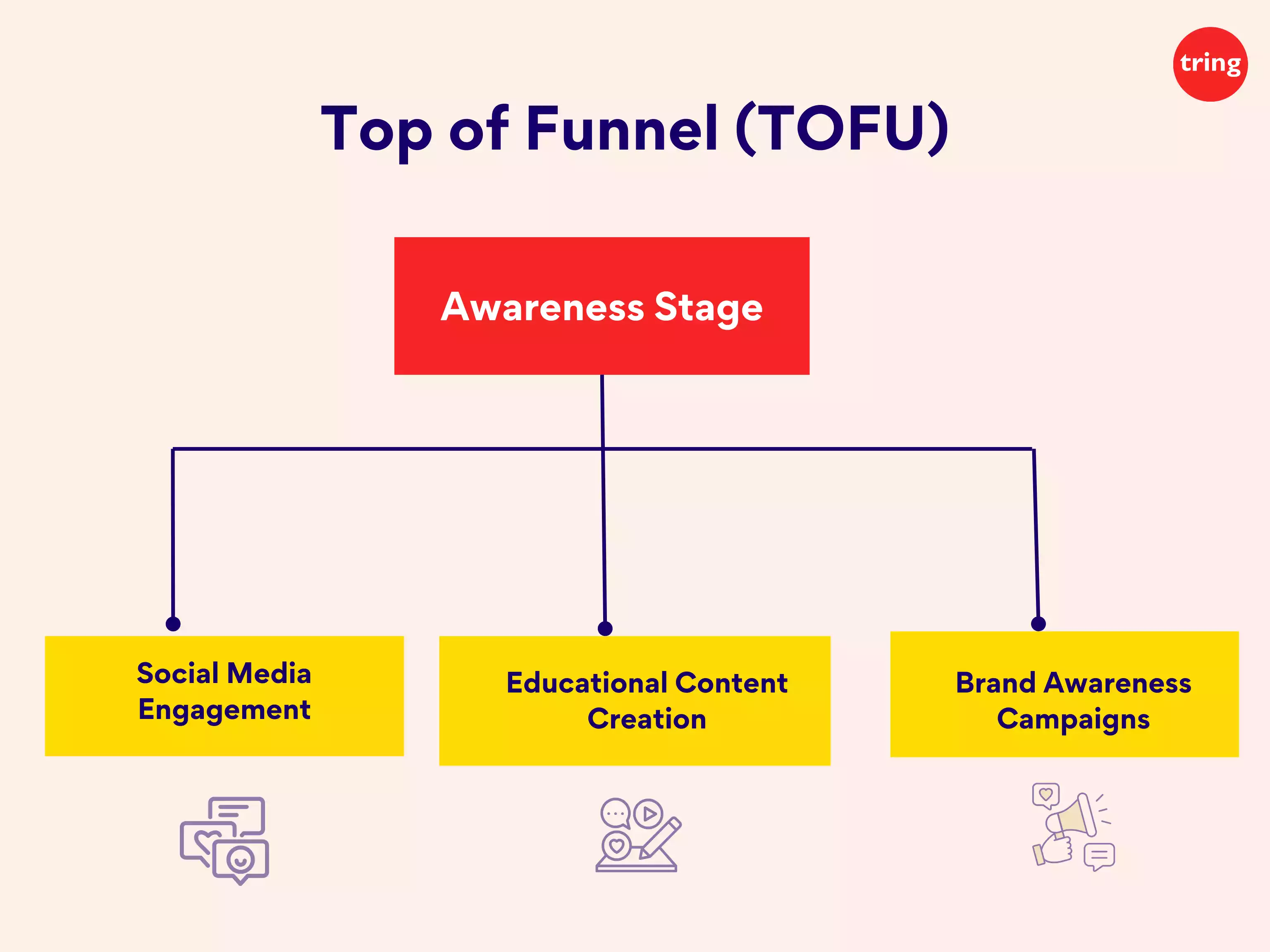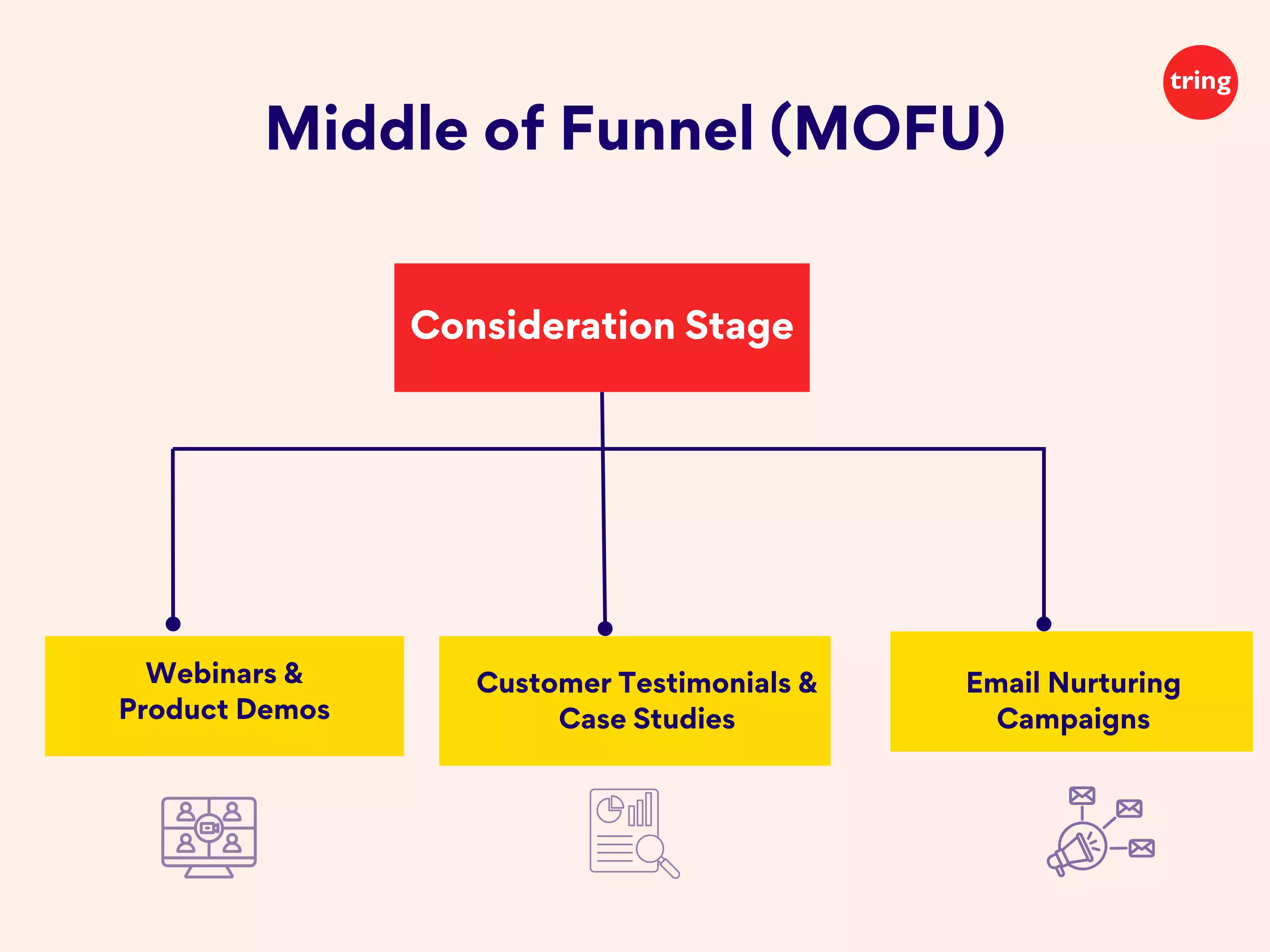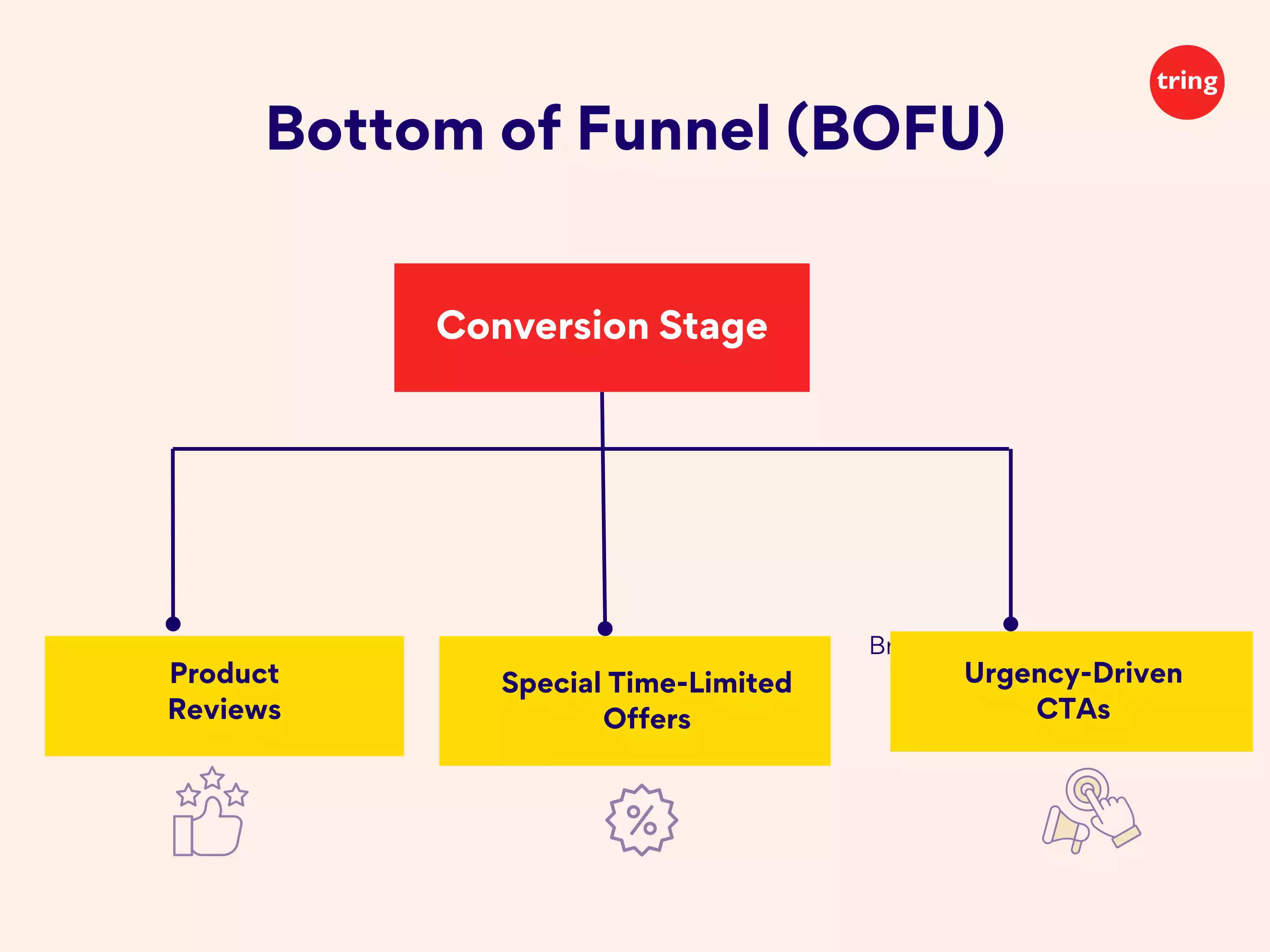1. Top of Funnel (Awareness)
![Top of Funnel (TOFU) Top of Funnel (TOFU)]()
At this point, visibility is foremost. You're exposing your brand to individuals who have never had the pleasure. It's getting into a room and making that initial impression. You're not asking for the sale yet, just get noticed. This is where wide-reaching influencer marketing campaigns, social media hype, and fun or informative content serve best.
2. Middle of Funnel (Consideration)
![Middle of Funnel (MOFU) Middle of Funnel (MOFU)]()
Now that the audience is familiar with who you are, they begin comparing. They might read your product reviews, visit your website, research your product, or follow you on social media. It's the brand's work to establish trust at this point. Influencer partnerships during this stage typically revolve around storytelling, product use, or relatable problems your product rectifies.
3. Bottom of Funnel (Conversion)
![Bottom of Funnel (BOFU) Bottom of Funnel (BOFU)]()
This is the most important phase, and also the most fragile. The individual is on the verge of a decision. They've researched. Now they require merely a nudge, a reason to believe, a motivation to act, or a streamlined experience to go out and buy, join, or subscribe. This is the Bottom of the Funnel (BOFU). It's where your Return on Interest (ROI) gets put to the test. BOFU is all about action. And it's not about reach or likes anymore, it's about outcomes. But here's where most marketers get it wrong. They think influencers are only valuable at the awareness stage. That's not even close to true. When executed correctly, influencer marketing can be a strong conversion driver, particularly when combined with BOFU strategies.
Tracking Bottom of Funnel Influencer Campaign Success
When you're spending money on influencer marketing for bottom-of-the-funnel objectives, success cannot be determined by likes, shares, or reach alone. Now that we're at this point, what counts is action: how many individuals purchased the product, enrolled in the service, or subscribed after having seen the influencer's material. To ensure your efforts are translating, you require a transparent and traceable process. Fortunately, some tools and strategies assist brands in linking influencer activity to BOFU outcomes. Let's dive deeper into each:
1. Affiliate Links
A special URL is provided to every influencer, an affiliate link. It allows you to see who referred which customer to your site and if the person converted or not. It's widely utilized in e-commerce, subscription, and apps. This approach is accurate and enables you to compensate influencers for genuine outcomes.
Example: A fitness company provides a fitness influencer with an affiliate link to a protein powder. Each sale made using the link earns the influencer a commission. The company, meanwhile, receives advanced analytics of how much money the influencer personally brought in. This performance-driven model is wonderful for BOFU campaigns because it's outcome-driven.
2. Discount Codes
Custom promo codes are another strong method to measure BOFU performance. Not only do these codes incentivize the audience to buy, but they also enable the brand to determine how many conversions were driven by a specific creator.
Example: A fashion brand offers a summer sale and provides influencers with codes such as RIA10 or ARJUN15 for 10% off. Audiences have faith in these fashion influencers and feel they're being offered a special deal. The brand can monitor how many users used each code, enabling them to quantify reach and conversion rate. This tactic generates a sense of urgency and exclusivity, two powerful conversion triggers.
3. Targeted Landing Pages
One of the most intelligent methods of measuring an influencer campaign's actual influence is through the use of custom landing pages and UTM-tagged links and analytics tools. Rather than sending traffic to a generic homepage, brands can build influencer-specific landing pages that have a unified narrative. These pages can include influencer videos, product suggestions, testimonials, special offers, and clear CTAs, basically acting as a conversion-driven microsite.
Example: A travel insurance brand partners with a vlogger and hosts www.brandname.com/travelwithananya. The site features a vlogger's personal video, a promo that lasts for a limited time, and a "Buy Now" option. With UTM tracking enabled, the brand can monitor exactly how well Ananya's campaign worked, from every click to every sale.
This methodology not only optimises performance. It enables brands to distinguish influencers who create awareness from those that create actual outcomes.
Types of Influencer Content That Drives Bottom of Funnel Goals
At the bottom of the funnel, the focus is on actionable content, stuff that convinces the audience to make a purchase, sign up, or subscribe right now. The content must feel personal, trustworthy, and urgent. Influencers can create content that pushes users down the funnel by showcasing how your product fits into their lives and why it’s the right decision. These are the kinds of influencer content that perform best for conversion and other BOFU objectives:
1. Product Reviews
Product reviews are perhaps the strongest kind of content in terms of converting potential customers. They display the influencer's genuine opinion, their experience with the product, and address any remaining questions or concerns a potential customer may have.
-
Why it works: Product reviews establish trust. They enable your audience to see that a real person, not only the brand, supports your product. It's not about puffery or hype; it's about genuine, down-to-earth feedback. A good review is a strong close, particularly when the influencer's audience trusts their judgment.
-
Example: A beauty brand that is rolling out a new acne remedy can collaborate with a beauty influencer who makes an in-depth review, featuring before-and-after photographs, discussing their regimen, and detailing how the product assisted. To conclude the review, the influencer includes an exclusive discount code for the viewers to utilize, making the transaction feel both special and rewarding.
-
Key takeaway: Ensure that your influencer reviews are genuine and reflective of their personality and followers. The more authentic the experience, the higher the conversion rate.
2. Testimonials
Influencer testimonials are concise, straightforward endorsements of how a product or service benefited their life. Compared to lengthy reviews, testimonials are usually faster, briefer, and centered around the core benefit of the product.
-
Why it works: Word-of-mouth selling is what people believe in. If an influencer posts a positive, first-hand experience in brief, punchy terms, it tends to come across as more authentic than a standard advertisement. Testimonials make the product seem like something that could change their life at this moment, prompting them to move quickly.
-
Example: Consider a male fashion influencer posting a story on Instagram with the words, "I've been wearing this new jacket from this company for a week and it's the most comfortable item I own. If you need something warm and fashionable, go take a look!" This plain but effective endorsement generates curiosity in the audience and can easily prompt a purchase.
-
Key takeaway: Make testimonials real and emphasize the most valuable aspects of your product that can persuade the customer they need it immediately.
3. Exclusive Offers and Promotions
Influencers are great at crafting exclusive offers that only their followers can take advantage of. Whether it's a time-sensitive discount, early bird access, or bundle offer, these promotions can nudge people off the fence and get them to act.
-
Why it works: Humans love to feel like they're receiving something exclusive, and limited-time promotions create a sense of urgency. When influencers endorse these promotions, they leverage the trust they've established with their followers, making the promotion feel more valuable.
-
Example: A technology brand may collaborate with an influential personality who has a large following to provide early access to their latest device to followers, along with a 15% discount for the influencer's followers only. This tech influencer highlights how short-lived the offer is, compelling followers to hurry before the offer runs out.
-
Key takeaway: Use limited-time offers or exclusive access to create urgency. Influencers can be used to reinforce that urgency by highlighting the time-sensitive nature of the offer.
4. How-To or Tutorial Content
How-to content is particularly powerful in the BOFU stage because it eliminates doubts and informs the audience precisely how to use the product. It's fine to declare your product fantastic, but demonstrating how it works and why it's easy to make a part of their life is different.
-
Why it works: How-to articles make it easy for your customers. It makes them imagine the step-by-step advantages of your product and feel safe and confident in their buying decision.
-
Example: A brand could collaborate with a yoga influencer who documents a workout on their equipment, narrating every move while quietly featuring the brand's equipment. The influencer demonstrates how convenient the product is to use, answers frequently asked questions, and illustrates how it can improve the workout experience.
-
Key takeaway: Tutorials or how-to videos can alleviate frequent customer questions and make the decision-making process easy. They are very engaging and build credibility by demonstrating the product.
5. Live Streams and Q&A Sessions
Live streaming is a great method of interacting with an audience live, responding to their questions, and demonstrating your product's value in a real manner. Through the use of live video, influencers can establish a stronger relationship with the audience and lead them towards a choice.
-
How it works: Live streams instill a sense of urgency and enable influencers to respond to live questions, dispelling any uncertainty the audience may have. Influencers can also provide exclusive offers or promotions to viewers while streaming, further stimulating instant action.
-
Example: A culinary brand collaborates with a food influencer to host a live session demonstrating the preparation of a meal using their home appliances. The influencer talks about how the appliances simplify cooking, answers questions from viewers, and gives an exclusive 20% off code that lasts for only the next 30 minutes.
- Key takeaway: Live streaming allows for real-time, interactive interaction with your audience, which can drive them to take immediate action.
How to Meet BOFU Targets with Micro and Nano Influencers
When most people hear the phrase influencer marketing, they probably think of large celebrities' endorsement or popular influencer personalities. But when it comes to conversions at the bottom of the funnel, micro and nano influencers tend to perform just as well, if not better. Let's examine why and how you can use them to drive your BOFU.
1. Why Micro and Nano Influencers Work for BOFU
Macro influencers' and micro/nano influencers' primary difference lies in engagement rather than in a macro or small follower count. While the latter has immense groups of fans, the former possesses closer-knit connections to tiny but very particular groups of folks. Their smaller following base would have very specific people who spend quality time watching out for what they want online.
For instance, a nano influencer might have only 1,000–10,000 followers, but a devoted crowd that waits for their every suggestion. They're regarded as peer-level influences and are perceived to be more natural and subjective compared to the highly refined brand content that tends to be generated by bigger influencers. This provides a perfect setting for driving conversions, sign-ups, and purchases. Their audience trusts them, respects their views, and is likely to act on product suggestions.
Example: If you’re a startup with a niche product (say a specialized fitness supplement), partnering with a micro influencer who already talks about health and wellness could be a great way to target potential buyers who trust their opinion. Their followers will be more likely to act on the influencer’s recommendation because it feels personal and honest.
2. Personalised and Targeted Messaging
Micro and nano influencers are generally experts; their content speaks deeply to a certain segment of individuals. This is priceless when it comes to BOFU marketing because you want your message to resonate with highly specific audiences. By engaging with micro or nano influencers who have a specific demographic, you can craft targeted messaging that addresses the specific pain points and needs of that audience. This is far superior to casting a broad message to a large, unfocused audience.
Example: Let’s say you’re a vegan beauty brand. Partnering with a beauty influencer who focuses on cruelty-free and vegan products can help your brand stand out to the exact audience that is most likely to convert. Their followers already align with your values, and their endorsement feels authentic and compelling.
3. Stronger Engagement and Trust
One of the key benefits of collaborating with smaller influencers is the increased engagement rates. Micro and nano influencers generally have smaller but more engaged audiences. They can readily respond to comments, answer DMs, and have direct conversations with their audience. This personal touch makes their endorsements feel much more authentic and relatable. Since the audience is personally invested in the influencer, they're more likely to act on a call to action, whether that means buying a product, subscribing to a service, or availing a special offer.
Example: A micro influencer who's popular for writing real, down-to-earth reviews can post about her experience with a new book. Since the influencer actively interacts with her audience, answering comments and talking to fans in the DMs, her followers are likely to believe her recommendation and buy based on that review.
4. Affordably Collaborating
Collaboration with macro influencers may increase costs, particularly for brands with a limited budget or those in the know in the process of starting up. Micro and nano influencers tend to be significantly cheaper and provide a higher return on investment (ROI) for BOFU objectives. Because these influencers are more specialized, they tend to charge less or even accept product swaps or performance-based arrangements (e.g., affiliate links or sales commissions). This makes them a great option for smaller brands or campaigns that must budget wisely but still desire to drive strong conversions.
Example: A new journaling app partners with a micro lifestyle influencer who regularly shares productivity and self-care content. The influencer posts a short video showing how they use the app to stay organized and includes a referral link or discount code. Since their audience is interested in wellness and daily routines, many of them sign up, helping the app grow through authentic and affordable promotion.
5. Long-term Relationships and Trust Building
When bottom-of-the-funnel objectives are concerned, creating a long-term relationship with influencers can prove to be much more effective than single-run campaigns. Long-term associations render the influencer's recommendation less of an advertisement and more like a natural endorsement. Such steady, authentic exposure assists in developing brand loyalty and trust over time, in turn, making future BOFU campaigns a success.
For instance, if an influencer has been posting about their affection for a particular fitness brand for years, their followers begin to assume that their endorsements are not paid but rather due to actual use. This trust becomes crucial when the influencer posts an exclusive deal or promo code. Followers are more likely to act since they are assured of the credibility of the brand.
Example: A skincare company could collaborate with a beauty micro-influencer for a few months. As time passes, the influencer gets linked to the brand in their audience's mind, gaining their trust. If the brand releases a new product, the audience of that influencer is most likely to buy, as they know they've watched them using the products repeatedly before.
Partner with Trusted Micro and Nano Influencers to Boost Conversions
![Collaborate with Top Micro and Nano Influencers Collaborate with Top Micro and Nano Influencers]()
Key Takeaways
Influencer marketing can be one of the most powerful tools in your bottom-of-the-funnel strategy, but it’s essential to approach it strategically. Here’s a quick summary of the key points:
-
BOFU goals focus on driving conversions, purchases, sign-ups, and subscriptions by targeting people who are already familiar with your brand and are now ready to take action.
-
Micro and nano influencers are highly effective for BOFU since they have high engagement, strong trust with their audience, and lower rates.
-
Influencers can produce content that establishes credibility and eliminates doubt, including product reviews, testimonials, special deals, how-to videos, and live streams.
-
For measuring success, utilize tools like affiliate links, promo codes, and trackable landing pages through which you can directly measure conversions.
-
Long-term influencer relationships result in more trust and improved outcomes over time.
In the right hands, influencer marketing for bottom-of-the-funnel objectives can not only encourage immediate action but also build long-term relationships with customers. Ensure you select the proper influencers, create engaging content, and utilize tracking tools to ensure you're meeting your objectives.
Looking to strengthen your influencer marketing efforts? Contact us for customized solutions that align with your business goals.
![Talk to Us Talk to Us]()
![birthday occasion]() Birthday Gifts
Birthday Gifts
![anniversary occasion]() Anniversary Gifts
Anniversary Gifts
![women]() Women
Women
![men]() Men
Men
![Couples]() Couples
Couples
![Couples]() Wedding Gifts
Wedding Gifts

 Birthday Gifts
Birthday Gifts
 Women
Women
 Men
Men
 Anniversary Gifts
Anniversary Gifts
 Wedding Gifts
Wedding Gifts






 We now support international payments
We now support international payments
